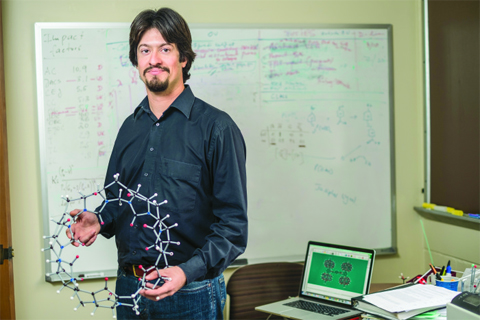
Eric Masson studies pumpkin-shaped Cucurbi-turil molecules.
By Amanda Biederman
NQPI writing intern
Named after the gourd family Cucurbitaceae, a unique group of molecules are known for binding things in tight complexes. While pumpkins are said to whisk fairy tale characters off to royal balls, the Cucurbiturils transport molecules to specific targets.
Ohio University Chemistry & Biochemistry professor and Nanoscale and Quantum Phenomena Institute member Dr. Eric Masson studies cucurbiturils, macrocyclic molecules that form a hollow, cylinder-like structure and contain oxygen atoms along their outer rims.
The cavities of Cucurbiturils are largely hydrophobic, and it is known that they bind hydrophobic “guests” readily in water. In a paper published in Organic Letters last August, Masson and Ph.D. student Ramin Rabbani showed that eight-unit cucurbiturils (i.e., CB[8]) can bind two guests at once, one being a hydrocarbon.
“(CB[8] is) basically a supramolecular handcuff that can connect two things together,” Masson said. “You have CB[8], and you have the (first) substituent … Then you have this cavity that is still available for an-other guest. In that remaining cavity … we captured hydrocarbons.”
In the paper, the team described the binding of 20 hydrocarbon guests, which they visualized using nuclear magnetic resonance spectroscopy. Now they are characterizing the binding of terpenoids, small molecules found in natural oils such as lavender and basil. The technique can be used to identify oils extracted from different geographic regions. The project, supported by the American Chemical Society Petroleum Research Fund, may be used in quality control and detection of counterfeit products.
Additionally, Masson is working on a project funded by the National Science Foundation on the development of CB[8] dynamic polymers that regulate biological systems. The team is synthesizing molecules that link to cucurbiturils on either side, forming a long chain with properties reminiscent of alpha helical structures of proteins. While the central chain is rigid, the substituents can bind biological targets, such as enzymes and other proteins involved in pathological pathways.
Masson said this research may play a major role in drug delivery, allowing for precise, effective treatments that minimize off-target side effects for patients. His group is currently writing two papers on the project.



















Comments